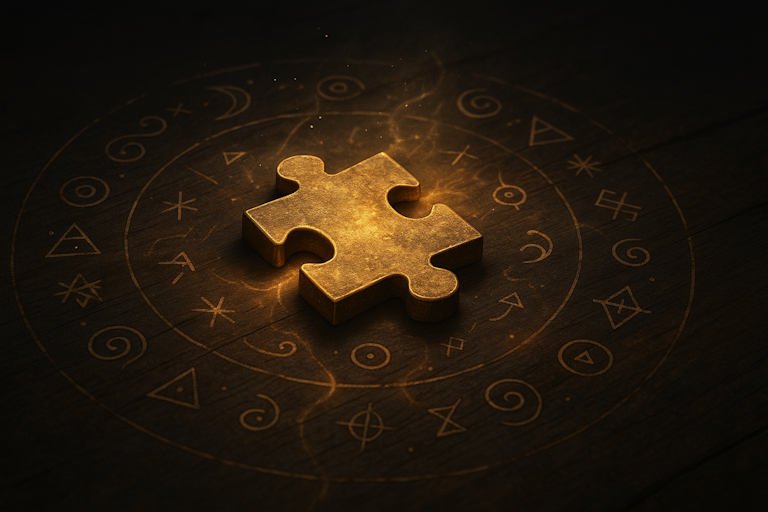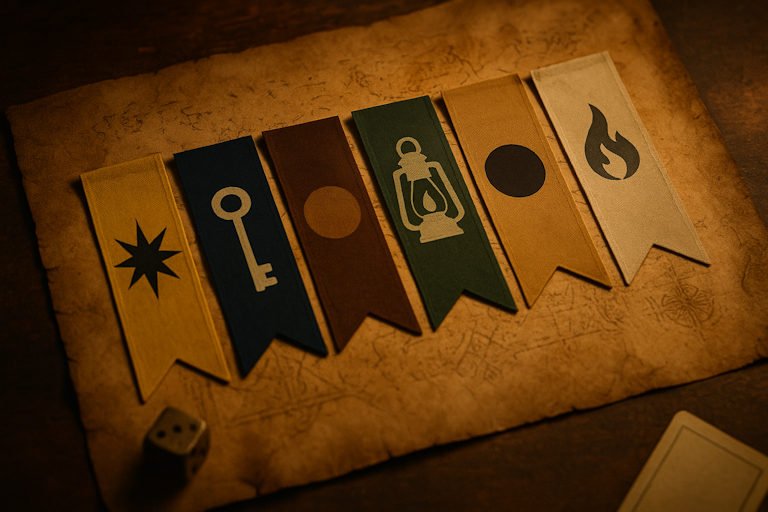
Symbolism in mystery games: the powerful emotions behind every puzzle (2025)
Symbolism in mystery games has always carried a special allure. Beyond puzzles and mechanics, it is the symbols—the keys, masks, mirrors, and doors—that hold our attention. They speak a language older than the games themselves, whispering promises of secrets waiting to be revealed.
These symbols work because they connect with something deeper. A locked chest is more than an obstacle; it represents hidden truth. A flickering candle signals both hope and fragility. By weaving such images into play, designers tap into the emotions and expectations that shape our experience.
In this article, we explore how symbolism in mystery games transforms simple puzzles into layered adventures. From archetypes that echo across cultures to subtle icons that guide our choices, we uncover why symbols remain the heartbeat of mystery.
Symbolism in mystery games: archetypes, icons & meaning
Symbolism in mystery games begins with archetypes that are as old as storytelling itself. These recurring images—keys, doors, mirrors, masks—are instantly recognizable, carrying layers of meaning that go beyond the mechanics of play. They are shortcuts to emotion and expectation, weaving depth into even the simplest puzzle.
Archetypes matter because they live in our collective imagination. A key doesn’t just open a lock; it represents knowledge, access, or revelation. A mask conceals identity but also raises the question of what lies beneath. These meanings exist before the game begins, so when they appear in play, they resonate immediately.
Icons extend this symbolic power. Designers often use repeated motifs—like colors, shapes, or emblems—to hint at alliances, dangers, or secrets. A recurring raven or spiral becomes a breadcrumb trail for players, guiding interpretation without explicit explanation. This implicit communication is powerful: players feel clever when they notice patterns, yet they are gently steered by design.
Meaning grows when these symbols are layered. In well-crafted mystery games, a single object often carries multiple interpretations. A candle may light a path, measure time, or signal hope—and it is precisely this ambiguity that makes it compelling. By forcing players to consider different possibilities, symbols create tension and invite speculation.
Ultimately, symbolism in mystery games works because it turns objects into more than tools. Symbols transform a puzzle from a task into a story. They connect the external logic of gameplay with the internal logic of human imagination, ensuring that every solved riddle feels like a revelation of meaning as much as mechanics.

Uncover
The Firefly Inn
Behind its lantern light, secrets wait to be revealed. Step closer, and choose your path into the unknown.
How symbols shape atmosphere and expectation
The presence of symbolism in mystery games does more than decorate the scene—it sets the tone and directs how players feel before a single puzzle is solved. Symbols shape atmosphere by whispering meaning into the background, creating tension long before players understand why.
A flickering lantern, for example, instantly signals uncertainty. Even if it is never mentioned again, the image makes the environment feel fragile. Similarly, a locked chest does not only hide an object; it creates the expectation that something important lies within. Through symbols, the ordinary becomes loaded with anticipation.
Color is another silent guide. Dark hues often hint at secrecy or danger, while gold and silver suggest value or truth. When these associations appear repeatedly, players begin to sense where to focus attention. A red mark on a wall may be dismissed once, but when it returns again and again, it transforms into a clue.
Symbols also manage rhythm. A recurring emblem—like a spiral, raven, or eye—builds suspense through repetition. Each appearance adds weight, leaving players uneasy until its meaning is revealed. This controlled uncertainty is what makes mystery games addictive: players feel they are piecing together a language, one symbol at a time.
Finally, atmosphere thrives on ambiguity. A mirror in the corner may be nothing—or it may hold the secret to the entire puzzle. By leaving space for interpretation, designers let players project their own fears, hopes, and expectations. This interplay of clarity and doubt keeps players emotionally engaged.
In the end, symbols don’t just support the story; they are the story’s pulse. By shaping atmosphere and expectation, symbolism in mystery games ensures that every glance at a detail feels like a step closer to revelation.

Uncover
The Firefly Inn
Behind its lantern light, secrets wait to be revealed. Step closer, and choose your path into the unknown.
Five ways symbolism elevates mystery games
Symbols are more than decoration; they are the hidden engines that drive emotion and meaning. Here are five ways symbolism in mystery games transforms simple puzzles into unforgettable experiences:
- Igniting curiosity: A single unexplained symbol makes players lean closer. The hint of hidden meaning turns even small details into mysteries worth solving.
- Creating “aha!” moments: When the true significance of a symbol is revealed, it delivers satisfaction beyond mechanics. The recognition feels earned, as if players cracked a secret code.
- Strengthening identity; Symbols tie games to archetypes and themes, giving each world a distinct personality. A raven, a spiral, or a key becomes shorthand for the entire atmosphere of play.
- Deepening emotional resonance: Symbols connect to universal feelings—hope, fear, wonder. A candle in the dark is never just light; it is comfort against uncertainty. These layers make play more human.
- Anchoring memory: Players may forget the details of a puzzle, but they remember the symbol that defined it. The image of the mask or key becomes the story they carry forward.

Together, these elements show how symbolism in mystery games elevates play from logic alone into layered experiences of meaning and emotion.
Design tips: using symbolism wisely
Symbolism in mystery games is powerful, but like all powerful tools, it must be handled with care. Too much or too obvious, and it loses its magic. Too little, and it feels like decoration without depth. The art of design lies in balance.
The first principle is consistency. A symbol should carry the same weight each time it appears. If a raven signals danger in one scene, it should not suddenly represent wisdom in another unless the shift is intentional and supported by story. Consistency builds trust in the symbolic language of the game.
Second, designers should embrace subtlety. The best symbols are those that players notice without being told. A recurring spiral carved into stone may spark questions long before its meaning is revealed. When the revelation finally comes, the payoff feels earned.
Another key is layering. Symbols can operate on multiple levels: a candle may be a light source, a timer, and a metaphor for fleeting life. When objects serve both mechanical and thematic roles, players experience them as richer and more immersive.
At the same time, beware of clichés. Overused icons—like the “mysterious eye” or the “skull”—can feel predictable unless they are given a fresh twist. The challenge for designers is not to avoid familiar images, but to present them in ways that surprise.
Finally, test the emotional impact. Symbols should evoke curiosity, tension, or awe—not confusion or frustration. When used wisely, symbolism in mystery games elevates the atmosphere and ensures that meaning lingers long after the puzzle is solved.
Conclusion – Why symbolism in mystery games endures
The enduring power of symbolism in mystery games lies in its ability to weave meaning into every detail. Long after players forget the mechanics of a riddle, they remember the candle that flickered, the mask that concealed, or the key that finally opened the door. These images do more than decorate the game; they turn puzzles into experiences that feel personal, emotional, and unforgettable.
What makes symbolism so compelling is its subtle conversation with the player. Each symbol hints at layers waiting to be uncovered, pulling us deeper into the atmosphere. Unlike pure logic puzzles, which can be solved and set aside, symbolic puzzles linger because they resonate with universal archetypes. We recognize them instinctively, even if we cannot always explain why.
For designers, this means that symbols are among the most versatile tools in their craft. They can build suspense, direct attention, or trigger an “aha!” moment without a single line of text. But their strength also demands care: symbols must be consistent, layered, and emotionally rich. When they are used wisely, the entire game world becomes more than a stage—it becomes a story that players help to uncover.
For players, the presence of symbolism transforms play into something deeper. Each discovery feels like insight rather than victory, and each twist carries a weight that transcends the board or screen. This is why mystery games resonate so strongly: they are not just about finding solutions, but about finding meaning.
Ultimately, symbolism in mystery games reminds us that the smallest image can carry the greatest power. A puzzle piece becomes a revelation, a flicker of light becomes hope, and in the silence between symbols, imagination fills the rest.

Uncover
The Firefly Inn
Behind its lantern light, secrets wait to be revealed. Step closer, and choose your path into the unknown.




